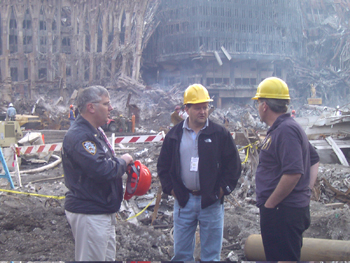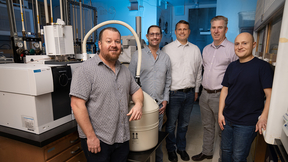Lab continues to answer the call for security
 (Download Image)
(Download Image)
The Lab's Mike Carter, center, talks with first responders at ground zero days after the 9/11 attacks.
Ten years ago, in the wake of the worst terrorist attacks on American soil, dozens of Laboratory employees were directly involved in the nation's response on Sept. 11, 2001 and in the days and weeks that followed.
Within hours of the attacks, phone calls streamed into the Laboratory from across the federal government with requests for assessments and analyses, for experts and equipment. In addition, Lab people came forward with novel ideas and offers to help, both in the immediate aftermath and in the longer-term war on terrorism.
More than 60 Laboratory employees in a dozen different groups were deployed to New York City, Florida, Washington, D.C. and other locations. People on and off site worked around the clock for weeks.
Almost immediately after the two planes crashed into the World Trade Center towers, the Nuclear Emergency Support Team (NEST) was put on alert, and within days Z Division analysts went back to Washington, D.C. to support the CIA's Technical Experts Cell and other elements of the intelligence community.
The Laboratory's Threat Assessment Center was up and running as soon as word of the attacks was received -- around the clock initially and then settling into an 18-hour-a-day, seven-day-a-week operation. In the 10 weeks following 9/11, the Threat Assessment Center provided 63 assessments -- more than their entire caseload in the previous year.
Numerous calls went out for specialized equipment to assist in search and recovery efforts at the World Trade Center and to help protect the nation from new attacks. In many cases, prototype instruments were taken out of laboratories and used in the field, where they performed well.
On Sept. 12, the office of the Secretary of Energy and a four-star Air Force general phoned the Lab to ask whether micropower impulse radar (MIR) could be used as a breathing/heartbeat sensor to search for survivors in the World Trade Center rubble. The next day, a team of 10 employees -- from Engineering, Hazards Control, and Nonproliferation, Arms Control and International Security (the forerunner organization to Global Security) -- departed from Stockton in Energy Secretary Spencer Abraham's government aircraft (all commercial planes were grounded) for New York City's LaGuardia Airport.
The radar technology went into operation early Saturday morning, Sept. 15, with Lab employees working 14- to 16-hour days under a New York City Fire Department battalion commander. (No survivors were found by any means after Sept. 12.)
A dozen Laboratory employees helped monitor the air around the World Trade Center for hazardous emissions. When the call for assistance was received, the instrument to be used was in pieces in the laboratory. In four days, the instrument was reassembled, checked out, and flown to the East Coast.
The team was asked to search for asbestos contamination and for toxic gases that could affect recovery workers on the rubble pile. In particular, the World Trade Center's north tower contained the world's largest air conditioning system, with an enormous supply of freon in its refrigerant tanks, and there was concern that leaking freon could burn to produce chlorofluorocarbonyls, such as the toxic gas phosgene.
Although rescue workers had gone into the north tower basement, they had been unable to determine if the refrigerant tanks were leaking. The Livermore team found that the tanks were leaking but not producing toxic gases.
On Oct. 4, the nation was stunned with the anthrax-in-the-mail attack at the Florida headquarters of the American Media Company. Shortly thereafter, seven Lab employees were deployed to Florida to help screen U.S. mail. They used their prototype Bioaerosol Mass Spectrometer, which can analyze biological samples straight from an aerosol without a sample preparation step, to screen for mail contaminated with bacillus spores. (One species of bacillus, B. anthracis, causes anthrax.)
In the wake of the anthrax attacks, calls went out for any and all kinds of biodetectors, including the Laboratory's Handheld Advanced Nucleic Acid Analyzer (HANAA). This instrument was the first truly portable, battery-operated, handheld DNA analyzer. HANAA technology was in the process of being licensed to a commercial manufacturer, with first commercial units planned for spring 2002. To help the company meet an order from the U.S. military for 50 HANAAs, the Laboratory's Microtechnology Center launched a crash program to fabricate 300 thermal cyclers (silicon chambers used for rapidly heating and cooling samples) -- the key component of miniaturized PCR instruments.
The calls alerting the Biological Aerosol Sentry and Information System (BASIS) team members that they would be leaving California came at 1 a.m. on Saturday, Oct. 6. Within eight hours, BASIS personnel and tons of equipment were loaded on a C-130 cargo plane and took off from Travis Air Force Base.
Less than a day after their arrival, air samplers and communications were set up, and the portable laboratory was ready to accept samples. A joint project of Livermore and Los Alamos national laboratories, BASIS had been scheduled for use in February 2002 at the Salt Lake City Winter Olympics. It was pushed into operation four months early and performed exactly as designed. In mid-October, one Laboratory associate director received an e-mail from a BASIS team member that said: "If this isn't terribly coherent, it's because I've been up 36 hours and it's 3 a.m. This work offers a really great incentive to write computer software so that on-site support isn't needed."
A year after the 9/11 attacks, Laboratory equipment and personnel continued to be deployed. Prototype technologies that were "tested" in the field after 9/11 continued to be refined based on their real-world experience. The development of other technologies was accelerated and new efforts begun.
Laboratory scientists provided technical advice to the Office of Homeland Security and assisted the National Nuclear Security Administration with the transition to the Department of Homeland Security. The projects noted above are highlights of the Laboratory's extensive post-September 11 response. Many other projects, staffed by many more people, rallied to the cause and even now, 10 years after Sept. 11, 2001, are making important contributions to homeland security.
Contact
Stephen P Wampler[email protected]
925-423-3107
Tags
Global SecurityStrategic Deterrence
Featured Articles







